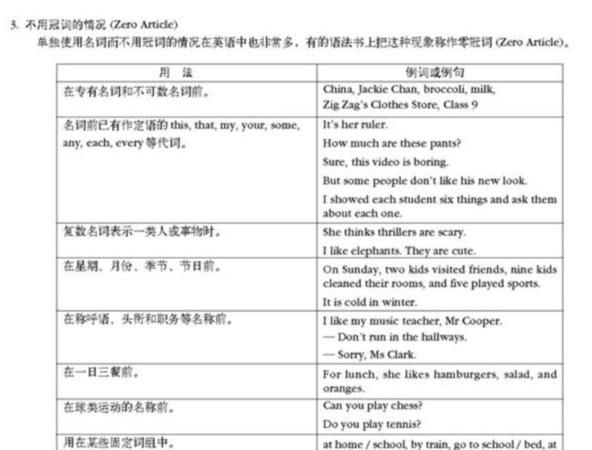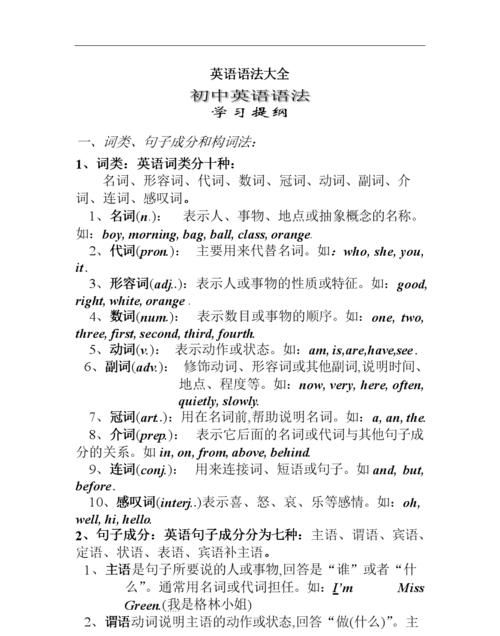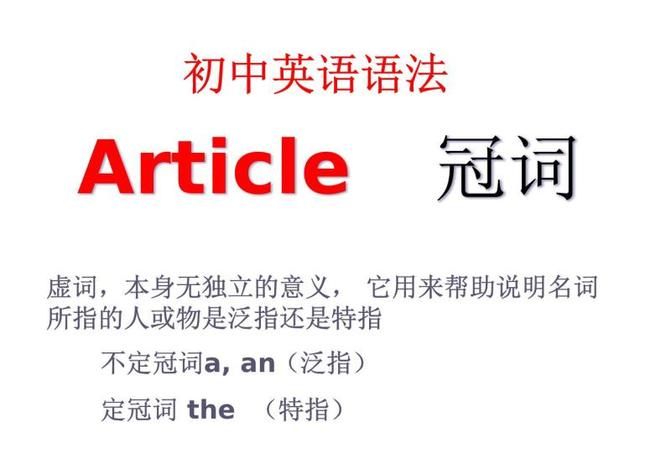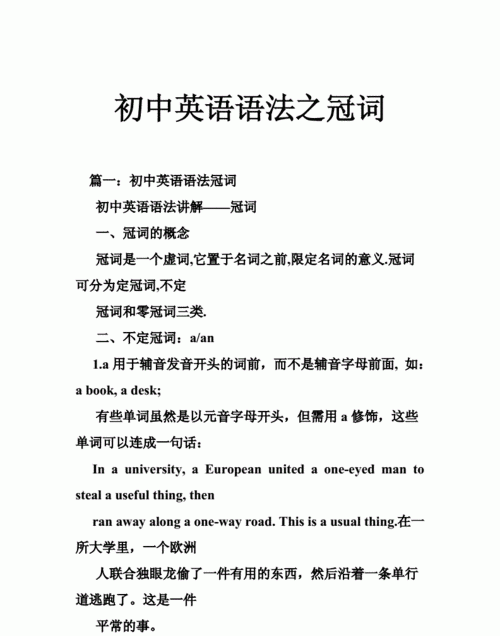本文目录
初中英语语法冠词教学设计

初中英语语法冠词讲解视频
初中英语语法——冠词练习题
【冠词】
用适当的冠词填空,不需要冠词的空白处填“×”
1. Tomorrow is ______ Teachers' Day and we'll make ______ card for our English teacher.
2. The bus is running about seventy miles_____ hour.
3. Mary is interested in ______ science.
4. Some people don't like to talk at ______ table.
5. Last night I went to______ bed very late.
6. Don't worry. We still have ______ little time left.
7. What ______ beautiful day! And what ______ fine weather!
8. In ______ winter it is cold in ______ Beijing and warm in ________Shanghai.
9. John is______ cleverest boy in his class.
10. We can't live without ______ water or ______ air.
11. Tomorrow Mr. Smith will leave Paris, ______capital of______ France, for Washington by______ air.
12. We were having______ lunch when they came in.
13. This is ______ book you gave me last week.
14. What did you do ______ last Saturday?
15. March 8 is ______ Women's Day.
16. If ______ weather is fine tomorrow, we will go to the park.
17. I prefer playing ______ piano to playing ______ basketball.
18. At ______ age of five, he read a lot of books.
19. Tom and Lucy are of ______ same age.
20. ______ harder we study, ______ more we learn.
冠词答案:1. ×; a 2.an 3. × 4. × 5. × 6. a 7.a; × 8. ×; ×; × 9.the 10.×; × 11. the; ×; × 12. × 13.the 14.× 15. × 16.the 17.the; × 18.the 19.the 20. The; the

初中英语语法要点,及怎样提高语法水平?
学习提纲
一,词类,句子成分和构词法:
1,词类:英语词类分十种:
名词,形容词,代词,数词,冠词,动词,副词,介词,连词,感叹词.
1,名词(n.): 表示人,事物,地点或抽象概念的名称.如:boy, morning, bag, ball, class, orange.
2,代词(pron.): 主要用来代替名词.如:who, she, you, it .
3,形容词(adj..):表示人或事物的性质或特征.如:good, right, white, orange .
4,数词(num.): 表示数目或事物的顺序.如:one, two, three, first, second, third, fourth.
5,动词(v.): 表示动作或状态.如:am, is,are,have,see .
6,副词(adv.): 修饰动词,形容词或其他副词,说明时间,地点,程度等.如:now, very, here, often, quietly, slowly.
7,冠词(art..):用在名词前,帮助说明名词.如:a, an, the.
8,介词(prep.): 表示它后面的名词或代词与其他句子成分的关系.如in, on, from, above, behind.
9,连词(conj.): 用来连接词,短语或句子.如and, but, before .
10,感叹词(interj..)表示喜,怒,哀,乐等感情.如:oh, well, hi, hello.
2,句子成分:英语句子成分分为七种:主语,谓语,宾语,定语,状语,表语,宾语补足语.
1,主语是句子所要说的人或事物,回答是"谁"或者"什么".通常用名词或代词担任.如:I'm Miss Green.(我是格林小姐)
2,谓语动词说明主语的动作或状态,回答"做(什么)".主要由动词担任.如:Jack cleans the room every day. (杰克每天打扫房间)
3,表语在系动词之后,说明主语的身份或特征,回答是"什么"或者"怎么样".通常由名词,代词或形容词担任.如:My name is Ping ping .(我的名字叫萍萍)
4,宾语表示及物动词的对象或结果,回答做的是"什么".通常由名词或代词担任.如:He can spell the word.(他能拼这个词)
有些及物动词带有两个宾语,一个指物,一个指人.指物的叫直接宾语,指人的叫间接宾语.间接宾语一般放在直接宾语的前面.如:He wrote me a letter . (他给我写了一封信)
有时可把介词to或for加在间接宾语前构成短语,放在直接宾语后面,来强调间接宾语.如:He wrote a letter to me . (他给我写了一封信)
5,定语修饰名词或代词,通常由形容词,代词,数词等担任.如:
Shanghai is a big city .(上海是个大城市)
6,状语用来修饰动词,形容词,副词,通常由副词担任.如:He works hard .(他工作努力)
7,宾语补足语用来说明宾语怎么样或干什么,通常由形容词或动词充当.如:They usually keep their classroom clean.(他们通常让教室保持清洁) / He often helps me do my lessons.(他常常帮我做功课) / The teacher wanted me to learn French all by myself.(老师要我自学法语)
☆同位语通常紧跟在名词,代词后面,进一步说明它的情况.如:Where is your classmate Tom (你的同学汤姆在哪里 )
3,构词法:英语构词法主要有:合成法,派生法和转换法.
1,合成法:如:spaceship, headache, basketball, playground等等.
2,派生法:
(1)派生名词:①动词+er/or ②动词+ing ③动词+(t)ion ④形容词+ness ⑤其他,如:inventor, learner, swimming, congratulation, kindness, carelessness, knowledge
(2)派生形容词:①名词+y ②名词+ful ③动词+ing/ed ④friendly ⑤dangerous ⑥Chinese; Japanese ⑦English ⑧French ⑨German ⑩国名+(i)an 如:snowy, sunny, hopeful, beautiful, interesting, follwing, daily(每日的),nervous, delicious
(3)派生副词:①形容词+ly ②其它,如:slowly, angrily, full→fully, good→well, possible→possibly等等.
3,转换法:
(1)形容词→动词,如:dry(干燥的)→dry(弄干), clean(干净的)→clean(打扫,弄干净),等等.
(2)动词→名词,如:look, walk, rest, work, study, swim, go, talk等等.
(3)名词→动词,如:hand(手)→(传递),face(脸)→(面对)等等.
(4)形容词→副词,如:early→early, fast→fast等等.
(5)副词→连词,如:when(什么时候)→(当……时候),等等.
(6)介词→副词,如:in(到……里)→(在里面;在家),on(在…上)→(进行,继续),等等.
二,名词:
1,英语名词可分专有名词和普通名词两大类:
1,专有名词是个别的人,地,物,团体,机构等的专用名称.
专有名词中实词的第一个字母要大写.
如:Beijing, Tom, the People's Republic of China(中华人民共和国)
专有名词如果是含有普通名词的短语,则必须使用定冠词the.如:the Great Wall(长城)
姓氏名如果采用复数形式,则表示该姓氏一家人(复数含义),如:the Greens( 格林一家人).
2,普通名词是许多人或事物的共有名称.如:pupil, family, man, foot.
普通名词又分为可数名词和不可数名词.
▲可数名词是可以用简单的数词进行计数的名词,如: box, child, orange;
▲不可数名词是不可以用简单的数词进行计数的名词.如:water, news, oil, population, information .
2,英语可数名词的单复数:英语可数名词有单数和复数两种形式.
1,名词由单数变复数的基本方法如下:
①在单数名词词尾加s.如:map → maps,boy→ boys,horse→ horses, table→ tables.
②s,o,x ,sh,ch结尾的词加es.如:class→classes, box→boxes, hero→heroes, dish→dishes, bench→benches.
[注]:少数以o结尾的词,变复数时只加s.如:photo→photos, piano→pianos.
③以辅音字母加y结尾的名词,变y为i,再加es.如:family→families, city→cities, party→parties.
④以f或fe结尾的名词,变f或fe为v,再加es.如:shelf→shelves, wolf→wolves, life→lives, knife→knives.
2,不规则变化:man→men, woman→women, sheep→sheep,tooth→teeth, fish→fish, child→children, ox→oxen, goose→geese
不可数名词一般没有复数形式,说明其数量时,要用有关计量名词.如:a bag of rice→two bags of rice, a piece of paper→three pieces of paper, a bottle of milk→five bottles of milk. 学习英语语法的网站: ***/zhongxiaoxueyingyu/2010/0204/9095.html

初中英语语法题冠词题3.When Linda was a child her mother always let her have____ bed. A. the
为你解答。
When Linda was a child, her mother always let her have (C.breakfast in) bed.
当Linda小时候,她妈妈总是让她在床上吃早餐。
解释:have breakfast,吃早餐,不用冠词;in bed,卧床,也不用冠词。

以上就是关于初中英语语法冠词 ,初中英语语法冠词教学设计的全部内容,以及初中英语语法冠词 的相关内容,希望能够帮到您。

